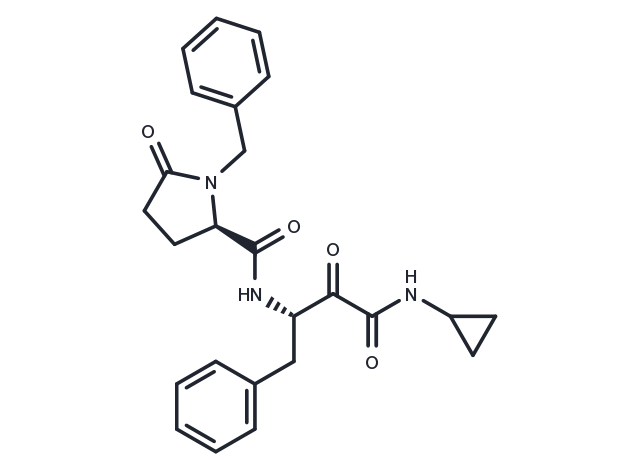Powder: -20°C for 3 years | In solvent: -80°C for 1 year


(1S,2R)-Alicapistat ((1S,2R)-ABT-957) is a highly efficient, orally active compound that selectively inhibits human calpains 1 and 2, with promising implications for Alzheimer's disease (AD) therapy [1]. This compound effectively addresses the metabolic liability associated with carbonyl reduction, while demonstrating potent inhibition of calpain 1 with an IC50 value of 395 nM [2].

| Pack Size | Availability | Price/USD | Quantity |
|---|---|---|---|
| 1 mg | In stock | $ 245.00 | |
| 5 mg | In stock | $ 612.00 | |
| 10 mg | In stock | $ 869.00 | |
| 25 mg | In stock | $ 1,320.00 | |
| 50 mg | In stock | $ 1,780.00 | |
| 100 mg | In stock | $ 2,380.00 | |
| 500 mg | In stock | $ 4,780.00 | |
| 1 mL * 10 mM (in DMSO) | In stock | $ 713.00 |

| Description | (1S,2R)-Alicapistat ((1S,2R)-ABT-957) is a highly efficient, orally active compound that selectively inhibits human calpains 1 and 2, with promising implications for Alzheimer's disease (AD) therapy [1]. This compound effectively addresses the metabolic liability associated with carbonyl reduction, while demonstrating potent inhibition of calpain 1 with an IC50 value of 395 nM [2]. |
| In vitro | (1S,2R)-Alicapistat fails to achieve sufficient concentrations in the central nervous system (CNS) for a pharmacodynamic effect [1]. It inhibits Calpain 1 (μ-calpain) and 2 (m-calpain) in a calcium-dependent manner, requiring μ-molar or m-molar calcium concentrations for activation. At 100 nM, (1S,2R)-Alicapistat (compound 22) prevents deficits in synaptic transmission caused by Aβ oligomer in rats [2]. Furthermore, at 385 nM, it effectively prevents NMDA-induced neurodegeneration and amyloid beta (Aβ)-induced synaptic dysfunction [2]. At concentrations ranging from 9-21 nM in cerebrospinal fluid (CSF), (1S,2R)-Alicapistat does not reach the IC 50 required for calpain inhibition, yet it exhibits no dose-limiting toxicities (DLTs) across broad population studies [3]. |
| In vivo | (1S,2R)-Alicapistat (compound 22) administered intravenously (iv) or orally (po) at doses of 1-3 mg/kg shows moderate plasma clearance rates (CLp) across several species, being lowest in mouse, rat, and dog (0.13-1.04 L/hr.kg) and significantly higher in monkeys (1.98 L/hr.kg). Its average steady-state volume of distribution (Vss) is observed to be moderate in mouse, dog, and monkey (0.64-1.8 L/kg), with rats displaying a notably higher value (3.4 L/kg). The compound’s plasma elimination half-life (t 1/2 ) varies among species, being the shortest in dogs (1.7 hours), and extending to 2.3 hours in monkeys and approximately 6.0 hours in both mice and rats. Oral bioavailability (F) demonstrates high absorption in mice, rats, and dogs (>80%), contrasting with a moderate rate in monkeys (14%) [2]. |
| Molecular Weight | 433.5 |
| Formula | C25H27N3O4 |
| CAS No. | 2221010-57-5 |
Powder: -20°C for 3 years | In solvent: -80°C for 1 year
DMSO: 45 mg/mL (103.81 mM), Sonication is recommended.
You can also refer to dose conversion for different animals. More
bottom
Please see Inhibitor Handling Instructions for more frequently ask questions. Topics include: how to prepare stock solutions, how to store products, and cautions on cell-based assays & animal experiments, etc.
(1S,2R)-Alicapistat 2221010-57-5 Proteases/Proteasome Cysteine Protease Alicapistat (1S,2R)Alicapistat inhibitor inhibit
